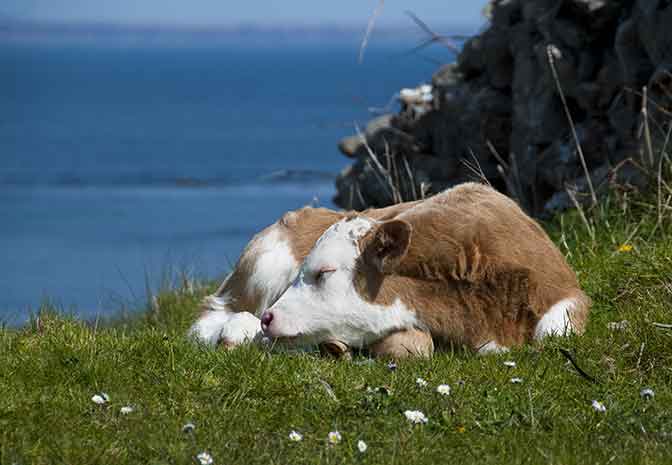There are few driving routes that rival the Wild Atlantic Way – the world’s longest coastal road. Lofty mountain peaks, towering crags, shimmering beaches and tranquil coves all illustrate the wild spirit of this mysterious land, creating the very essence of the Ireland made famous in poetry, music and film. In recent years, signposting along the Wild Atlantic Way has been improved, making it much easier for tourists to navigate the untamed terrain, so you can discover places such as Galway and the Aran Islands.
Live music and creativity in Galway

Galway, the historic capital of the Connacht province, has long been a beating heart of bohemian culture. Surrounded by rugged Atlantic Ocean beaches, this eclectic university town is fast becoming one of Europe’s coveted city break hotspots, famous for its uniquely convivial atmosphere.
The city’s bustling centre is a patchwork of colourful shops, quirky restaurants and cosy cafés, making it the perfect spot for a weekend getaway. Supremely talented buskers and street performers are a permanent fixture outside the brightly painted pubs of Quay Street, which almost always have a live band playing inside. As well as traditional Irish music, the pubs habitually belt out American classics, as many Galway families moved across the pond following the Great Irish Famine in the 19th Century. The city’s leafy Eyre Square is known to locals as John F Kennedy park, as it was established in memory of the Irish American president who visited here in 1963, months before he was assassinated. Boston, Massachusetts, is affectionately known as “the next parish over”.
Galway’s energy and creativity saw it named the European Capital of Culture in 2020. Crammed with ground-breaking art, sculpture, stand-up comedy, music and sport, the city provides all the ingredients for a scintillating summer on Ireland’s West Coast. There are also plenty of things to do in Galway for foodies, including festivals, markets, and tours.
While the most famous historic landmarks include Lynch’s Castle, Galway Cathedral and the Spanish Arch, don’t miss the Galway City Museum. Situated on the banks of the River Corrib, it’s humble in size but contains many fascinating fragments of the area’s past, including an exhibition on ‘Galway and the Great War’, which receives rave reviews from history buffs. There’s also a display dedicated to author Pádraic Ó Conaire, the first Irish modern fiction writer. Stop a while at his stone effigy: it has become one of Galway’s most prized features. Once mounted in Eyre Square, the monument suffered decapitation at the hands of drunken youths who tried make off with his head. Luckily though, they were intercepted by the Gardaí, who reunited Pádraic’s head and shoulders and placed him safely in the museum.
Desolate beauty and Gaelic tradition in the Aran Islands

Studded in Galway Bay are three glittering emeralds which form the Aran Islands. Venture to Inis Mór (Big Island), Inis Meáin (Middle island) and Inis Oírr (East island), where time appears to stand perfectly still. These intriguing isles are just a 45-minute ferry journey away from the mainland. If you’re seeking unblemished natural beauty, you’ll find the Aran Islands to be utopia. Millions of years ago, they were still attached to Clare on the mainland, which is why the terrain is made of the same limestone. Every year, the rock-strewn, desert landscape spawns rare flora, making the isles a haven for botanists and the local fauna. Visitors can marvel at a terrific cornucopia of colour throughout the summer which perfectly contrasts the grey mineral landscape.
800 or so islanders live in 14 hamlets, with fishing, farming and tourism being the chief sources of income for locals, who are fierce guardians of Irish traditions. They welcome thousands of visitors from across the world every year with outstanding warmth and hospitality. Stop by a pub and watch some traditional Irish hard shoe dancing, or sample some authentic cuisine such as Guinness stew or a freshly caught crab platter at one of the handful of restaurants. The best way to get around is by bike, or even a pony cart tour driven by a guide. The islands are Gaelic speaking and while the locals speak English for visitors, they tend to chat amongst themselves in the old Irish language.
Situated on the western edge of Europe, the ancient Celtic stronghold of Dun Aengus sits atop a cliff above the Atlantic, offering spectacular views. If you plan to visit the ruins, you’re advised to stay in Kilronan on Inis Mór. It’s the only real town on any of the three Aran Islands, though it has more of a village vibe. You’ll find just a handful of pubs, restaurants and B&Bs situated around its beautiful pier.
We offer routes to ports on the east coast of Ireland and Northern Ireland, from which you can easily drive to Galway and the Aran Islands. Check out the crossings we offer from Cairnryan to Larne and Liverpool to Dublin for more information.



